| Overview | |
|---|---|
| Service type | EuroCity (EC) |
| Status | active |
| Locale | Hungary Slovakia Czech Republic Germany |
| Predecessor | Primator , Vindobona |
| First service | 14 December 2014 |
| Current operator(s) | České dráhy, Deutsche Bahn |
| Route | |
| Termini | Budapest Keleti Hamburg-Altona |
| Stops | Praha hl.n., Berlin Hbf |
| Service frequency | Daily |
| Train number(s) | EC 172/173 |
| On-board services | |
| Disabled access | Wheelchair space and accessible toilet |
| Seating arrangements | First class open; second class compartment and open |
| Catering facilities | Dining car |
| Baggage facilities | Bicycle transportation |
| Technical | |
| Track gauge | 1,435 mm (4 ft 8+1⁄2 in) |
| Electrification | 15 kV AC, 16.7 Hz (Germany) 3 kV DC (Czech Republic) 25 kV AC, 50 Hz (Czech Rep., Slovakia, Hungary) |
The Porta Bohemica is a EuroCity (EC) international express train. Since December 2014 it is operating between Hamburg-Altona and Budapest Keleti.
The train's name, Porta Bohemica (Czech : Brána Čech; German : Böhmische Pforte), is the Latin word for the point where the Elbe river begins its passage through the České Středohoří (Central Bohemian Uplands or Bohemian Central Uplands).
From 1993 to 2003, a predecessor train of the same name ran between Prague, the capital of the Czech Republic, and a number of different termini in northern Germany.
The train takes the route via Berlin Hbf, Dresden Hbf, Praha hl.n., Brno hl.n. and Bratislava hl.st. A sister train named Jan Jesenius, composed of Hungarian and German rolling stock, is running two hours earlier from Budapest and two hours later from Hamburg.
In May 1993, there was a major reorganisation of the international train services through the Elbe valley. [1] It involved the introduction of four daily EuroCity expresses. Two existing trains, the Hungaria (Budapest–Hamburg) and the Vindobona (Vienna–Berlin) were upgraded to become EuroCity services, a new train, the EC Comenius (Prague–Berlin), was added to the timetable, and the Porta Bohemica replaced another existing train, the Primator (Prague–Berlin). All of these changes took effect from 23 May 1993. [2]
Initially, the Porta Bohemica ran between Praha-Holešovice in Prague and Hamburg-Altona in Hamburg. The northbound train, EC 176, was the last of the four daily northbound Elbe valley EuroCity services to leave Prague, in the early afternoon. The southbound train, EC 177, left Hamburg shortly after 08:00.
On 27 May 1995, the northern terminus of the Porta Bohemica was moved south, to Nauen, Germany (on the northwestern outskirts of Berlin), and the southern terminus in Prague was switched from Praha-Holešovice to Praha hl.n.. On 24 May 1998, the northern terminus was moved back to Hamburg, and in 2001 it was moved even further north, to Westerland (Sylt), also in Germany. At the end of the following year, in December 2002, it was moved yet again, back to Hamburg for the second time.
On 14 December 2003, all of the EuroCity trains running through the Elbe valley lost their names. Trains EC 176/177 continued to run without names for three years until 10 December 2006. But when the naming of the Elbe valley EuroCity trains was reintroduced, the name Porta Bohemica was not reused.
From 14 December 2014, a two-hourly clock-face schedule was introduced between Prague and Budapest, alternating with a railjet between Prague and Graz every other hour. This meant that the EC 172/173 Vindobona was replaced by the EC 172/173 Porta Bohemica Hamburg-Altona—Budapest Keleti. The connection in Praha to a Railjet via Wien Hauptbahnhof to Graz Hauptbahnhof and vice versa includes an hour of layover.
The train is currently hauled between Hamburg and Dresden by a DB Class 101 locomotive, between Dresden and Prague by a ČD class 371 locomotive and between Prague and Budapest by a ČD Class 380 locomotive. It is composed of rolling stock of the Czech Railways, one first class open coach Ampz143, one dining car WRmz815, five second class compartment coaches Bmz241/245. A German second class open coach Bpmbdz294 offers wheelchair space and bicycle transportation. Seasonally, another German second class open coach Bpmz294 without these special amenities is added.
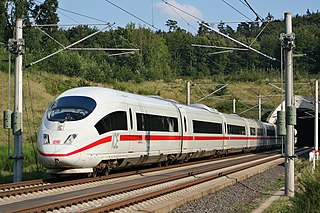
Intercity Express is a high-speed rail system in Germany. It also serves destinations in Austria, France, Belgium, Switzerland and the Netherlands as part of cross-border services. It is the flagship of the German state railway, Deutsche Bahn. ICE fares are fixed for station-to-station connections, on the grounds that the trains have a higher level of comfort. Travelling at speeds up to 300 km/h (190 mph) within Germany and 320 km/h (200 mph) when in France, they are aimed at business travellers and long-distance commuters and marketed by Deutsche Bahn as an alternative to flights.
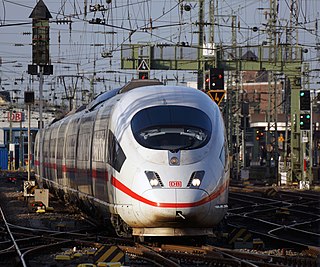
As of 2021, Germany had a railway network of 33,399 kilometres (20,753 mi), of which 20,540 kilometres (12,760 mi) were electrified and 18,556 kilometres (11,530 mi) were double track. Germany is a member of the International Union of Railways (UIC). The UIC Country Code for Germany is 80.

Dresden Hauptbahnhof is the largest passenger station in the Saxon capital of Dresden. In 1898, it replaced the Böhmischen Bahnhof of the former Saxon-Bohemian State Railway, and was designed with its formal layout as the central station of the city. The combination of a station building on an island between the tracks and a terminal station on two different levels is unique. The building is notable for its train-sheds, which are roofed with Teflon-coated glass fibre membranes. This translucent roof design, installed during the comprehensive restoration of the station at the beginning of the 21st century, allows more daylight to reach the concourses than was previously possible.

Railjet is a high-speed rail service in Europe operated by Austrian Federal Railways (ÖBB) and Czech Railways (ČD). Branded as Railjet Express (RJX) for the fastest services and as Railjet (RJ) for services with additional stops, it was introduced in 2008 and operates at speeds of up to 230 km/h (143 mph). Railjet is ÖBB's premier service and operates both domestically within Austria and on international services to adjacent major cities in the Czech Republic, Germany, Switzerland, Italy, Hungary and Slovakia.

The Děčín–Dresden railway, also called the Elbe Valley Railway is an electrified main line in Saxony and the Czech Republic. Formerly called the Saxon-Bohemian State Railway, the line is part of the Dresden to Prague route and is one of Europe's most important trunk routes (Magistralen). It runs along the Elbe Valley from Děčín via Bad Schandau and Pirna to Dresden. The first section of the line was opened in 1848 and is one of the oldest lines in Germany.

Kelenföld railway station is among Budapest's four busiest railway stations. Opened in 1861, it is situated south-west of the city centre, in Újbuda or District XI in the suburb Kelenföld.
The German rail network provides connections to each of its neighbouring countries, many of which are under the EuroCity classification. EuroCity services are part of the Intercity network - many EC services represented a couple of train pairs on an IC route extended across the border, while other routes are served primarily by EuroCity services. EuroCity services are generally locomotive-hauled, using Intercity rolling stock, either from Deutsche Bahn or one of the other countries along the route.

Intercity, often shortened to IC, is the second-highest train classification in Germany, after the Intercity Express (ICE). Intercity services are locomotive-hauled express trains, usually over long-distances. There are Intercity routes throughout Germany and routes generally operate every other hour, with multiple routes giving a more frequent service on core routes. Intercity services are operated by the DB Fernverkehr division of Deutsche Bahn, Germany’s national railway.

Praha-Holešovice railway station is located in Holešovice, a northern district of Prague, capital city of the Czech Republic. Opened in 1985, the station was originally used as a terminus for international fast trains coming from the east. Since the completion of the Nové spojení in 2010, however, these trains terminate at the more central hub, Praha hlavní nádraží. Nevertheless, international trains from hlavní nádraží running north to Dresden and Berlin, as well as northwest-bound inter-regional trains still call here. The station is adjacent to Prague Metro's Nádraží Holešovice station on line C and also to stops of the same name on lines 6, 12, and 17 of the city's tramway system, as well as a bus station.

The Vindobona is an international named passenger train which began service in 1957 between Berlin and Vienna via Dresden and Prague. In later years the route was extended to run from Hamburg via Berlin, Dresden, Prague, Brno and Vienna to Villach. It was named after the ancient settlement of Vindobona on the site of the modern city of Vienna. Labelled as a EuroCity train connection from 1993, services discontinued in 2014.

The Transalpin is a EuroCity express train linking Zürich (Switzerland) with Graz (Austria) via Liechtenstein. Introduced in 2013, it is operated by the Austrian Federal Railways (ÖBB) and the Swiss Federal Railways (SBB-CFF-FFS). From 1958 to 2010 a train of the same name linked Basel or Zürich with Vienna.
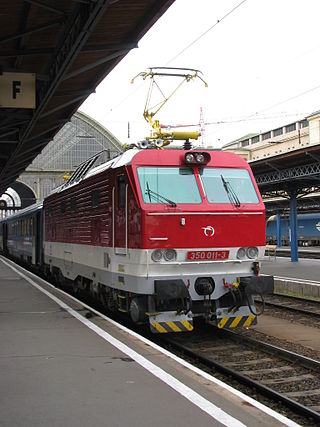
Hungaria is a EuroCity train which runs between Budapest Nyugati and Hamburg - Altona, currently running with coaches of MÁV. It is numbered as EC 172-173 and runs daily, mainly with MÁV owned rolling stocks.
The Primator was an international express train. Introduced in 1986, it ran between Prague, then the capital of Czechoslovakia, and East Berlin, then the capital of the German Democratic Republic (GDR).
The Lehár is an express train between Budapest, Hungary, and Vienna, Austria. Introduced in 1979, it was the first eastern European train to become a EuroCity service, in 1988.
The Comenius has been the name of two distinct EuroCity (EC) international express trains, both of them originating, terminating or passing through Prague, the capital of the Czech Republic.
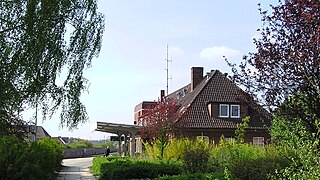
Büchen station is a railway junction in Büchen in the German state of Schleswig-Holstein. About 4,000 passengers embark or disembark each day.

ComfortJet is a high-speed push-pull train which is being built by Siemens Mobility and Škoda Transportation for the Czech train operator České dráhy and it is planned to start operations from summer 2024. Based on the Railjet, Siemens developed its Vectrain train family. It will operate at speeds of up to 230 km/h and will replace old carriages on international EuroCity services between the Czech Republic, Germany, Denmark, Austria, Slovakia and Hungary and on domestic InterCity services in the Czech Republic.
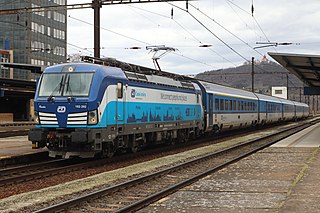
Siemens Vectrain is a family of locomotive-hauled push-pull trains built by Siemens Mobility. The Vectrain consists of a Vectron locomotive and Viaggio Comfort coaches or other coaches certified by Siemens. The last coach can be a control car, which has a cabin identical to Vectron locomotives. The trains are mostly used for InterCity and EuroCity services.